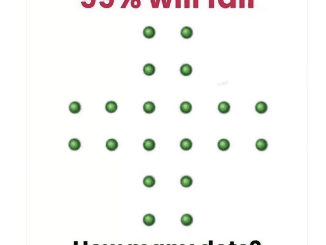In today’s digital age, social media is brimming with riddles and visual puzzles that challenge us to think critically and sharpen our observation skills. One such popular puzzle is the “spot the poor person” challenge, which presents an image of four individuals, each with distinct appearances that give clues about their socioeconomic status. The goal? To figure out who among them might be considered poor. Let’s delve into this puzzle, analyze each character’s visual cues, and determine why Person D stands out as the answer.

Observing the Characters: Setting the Scene
The image showcases four individuals labeled as Person A, B, C, and D, each with unique attire and accessories that hint at their lifestyles. By examining their clothing, posture, and belongings, we can gather subtle clues about their financial situations. Let’s go through each character and explore what their appearance might reveal about their economic status.
Person A: The Stylish Woman in Pink
Person A exudes a taste for fashion and luxury, evident in her trendy pink outfit and matching accessories.
- Appearance: She’s dressed in a bright pink dress, accessorized with jewelry and a designer handbag.
- Accessories: Shopping bags and a smartphone in hand indicate her comfort with modern technology and perhaps an affinity for retail therapy.
- Impression: The combination of stylish attire and shopping bags suggests that Person A has disposable income, likely a lifestyle that includes spending on non-essential items.
With her fashionable look and accessories, Person A does not give the impression of someone struggling financially. Her attire and belongings hint at a stable or affluent background, making it unlikely that she’s the “poor” person.
Person B: The Elderly Gentleman in a Suit
Person B presents himself as a dignified, older gentleman, with formal attire that reflects experience and stability.
- Appearance: Dressed in a neat suit and tie, Person B has a groomed appearance and a composed posture.
- Lifestyle Implication: His suit and formal presentation suggest familiarity with professional settings, potentially a career that afforded him financial stability.
- Impression: Wearing a suit implies a connection to a career or social environment that values formal wear, indicating that he likely experienced economic stability.
The refined look of Person B, combined with his formal suit, makes it improbable that he is poor. His attire points to a life marked by stability and perhaps even affluence, ruling him out as the answer.
Person C: The Professional Woman in Business Attire
Person C appears polished and professional, suggesting she’s financially secure due to a steady career.
- Appearance: She’s dressed in a business suit and carries a professional handbag, giving her a corporate look.
- Body Language: Her confident posture reflects comfort in a work environment, hinting at familiarity with professional settings.
- Impression: Her attire and demeanor imply that she likely has a stable income, as her outfit suggests a role that requires formal dress.
With her business attire and confident stance, Person C seems financially stable, likely from a career in a professional setting. She does not display any indications of financial struggle, making her an unlikely candidate for the “poor” person.
Person D: The Casual Young Man with Gadgets
Person D is dressed in a more laid-back, casual manner, contrasting sharply with the formality of the other individuals.
- Appearance: He’s wearing a hoodie and jeans, presenting a simple, casual look.
- Accessories: His possessions include headphones, a tablet, and a backpack, which hint at a student lifestyle.
- Impression: Although he has some gadgets, his casual attire and practical accessories suggest he might be on a tighter budget, possibly as a student managing with limited resources.
Person D’s practical style and modest possessions set him apart from the other individuals, who display signs of affluence. His student-like appearance, coupled with the absence of luxury items, suggests a more financially constrained lifestyle.
Why Person D is Most Likely to Be the “Poor” Person
After carefully examining each character, several clues point to Person D as the answer to the question, “Who is poor?” Here’s a breakdown of the factors that make Person D stand out:
- Modesty in Attire: Unlike Persons A, B, and C, who are dressed in professional or fashionable attire, Person D’s hoodie and jeans lack the sophistication associated with financial comfort. His outfit suggests a simple lifestyle, possibly on a budget.
- Student-Like Appearance: The backpack, headphones, and tablet imply he might be a student. Students often operate on tighter budgets and limited financial independence, which supports the idea that Person D might not have the same disposable income as the others.
- Functional vs. Luxury Accessories: Person D’s belongings, while modern, appear to serve a practical purpose rather than indicate wealth. In contrast, the other characters display accessories that hint at a higher socioeconomic status.
- Absence of Wealth Indicators: Unlike the other individuals, Person D doesn’t show any markers of wealth, such as jewelry, business attire, or luxury handbags. His casual look suggests he might be focused on essentials rather than luxury.

Understanding the Power of Observation: Spotting the Smallest Details
This puzzle is a reminder that sometimes, the answer lies in the smallest details. Our brains tend to focus on the obvious—Person A’s flashy attire or Person B’s formal suit—while overlooking subtler cues. Additionally, we often make assumptions based on stereotypes, like associating modern gadgets with affluence. However, a closer look at Person D’s simple style and practical accessories reveals a lifestyle marked by financial modesty.
This riddle encourages us to see beyond the surface and challenge our assumptions. By carefully analyzing each character’s accessories and attire, we can appreciate the nuances that reveal a person’s lifestyle and status.
Conclusion: Person D as the Most Likely “Poor” Individual
After examining each individual’s appearance, accessories, and implied lifestyle, it’s clear that Person D is the most likely candidate to be the “poor” person in this scenario. His casual attire, practical accessories, and modest demeanor point to a simpler lifestyle compared to the other individuals, who display signs of financial security.
This puzzle serves as a valuable exercise in observation and critical thinking. In riddles—and in life—careful attention to detail can reveal truths that are not immediately obvious. So, did you guess the answer right? If you enjoyed this puzzle, continue challenging yourself with more riddles to keep your mind sharp and your observation skills finely tuned!


